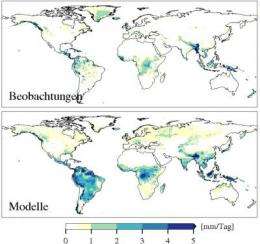Big uncertainties in the global water budget

No life without water. Catastrophes like droughts or strong rains reflect our dependence on the water cycle and climate system. Hence, it is important to understand details of the water cycle among the atmosphere, oceans, and land. A study in the Journal of Hydrometeorology now outlines significant differences of global models and measurement data sets. As the network of measurement stations worldwide is shrinking dramatically, uncertainties are increased.
"Climate change and the associated change of water availability are facts and will require partly significant adaptation," emphasize Ha-rald Kunstmann and Christof Lorenz of Karlsruhe Institute of Tech-nology, who are the authors of the said study. "This is the reason why we have to better understand interactions of evaporation, clouds, and precipitation also on the regional level." To check the reliability of various global analyses, the hydrologists and climate researchers reevaluated three of the most modern global coupled atmosphere and ocean models with respect to the water budget and compared the results with measurement data of the years 1989 to 2006.
"We found very big uncertainties in the global water budget esti-mates," says Kunstmann. The mean precipitations analyzed in some regions deviate by up to four liters per square meter and day. For comparison: In Germany, about two liters of rain fall per day and square meter on the average. Hence, these models do not allow for a reliable derivation as to when and where how much precipitation occurs. The models do not even provide simple relationships, such as that between the evaporation surplus above the oceans and pre-cipitation above the continents. "Models will continue to tell us with very big uncertainties how much precipitation and, hence, perma-nently renewed freshwater is available on earth."
"Data are insufficient for many regions of the world," explains Kun-stmann. "And the situation worsens." In South America, for instance, the number of measurement stations decreased from about 4350 to 550, e.g. by more than 84 percent (data basis: GPCC v5.0). A significant reduction can also be observed in Europe. Between January 1989 and December 2006, the number of precipitation measurement stations nearly halved from about 10,000 to 5800. About half of all European stations is located in Germany alone. "And without a solid data basis, water budget models cannot be improved decisively," Kunstmann says. "Quantification of the trends of rain and drought is aggravated considerably."
It is therefore urgently required to invest in precipitation measure-ment stations and to enhance meteorological services also in re-mote regions. "If we want to understand hydrological change and prepare for it effectively in the future, we will have to establish and maintain the necessary infrastructure," says Kunstmann.
More information:
Lorenz, C., and H. Kunstmann, 2012: The Hydrological Cycle in Three State-of-the-art Reanalyses: Intercomparison and Perfor-mance Analysis. J. Hydrometeor.
The study can be found online at: journals.ametsoc.org/doi/abs/1 … .1175/JHM-D-11-088.1
Provided by Helmholtz Association of German Research Centres


















